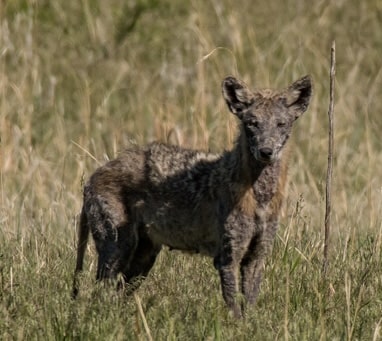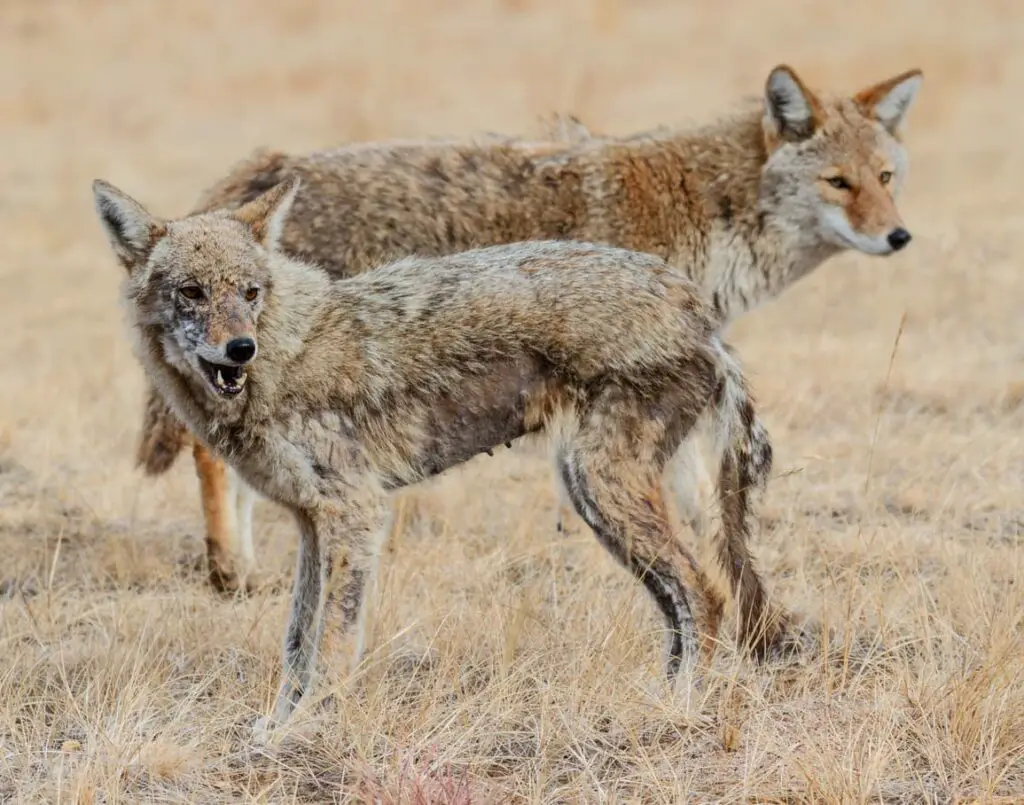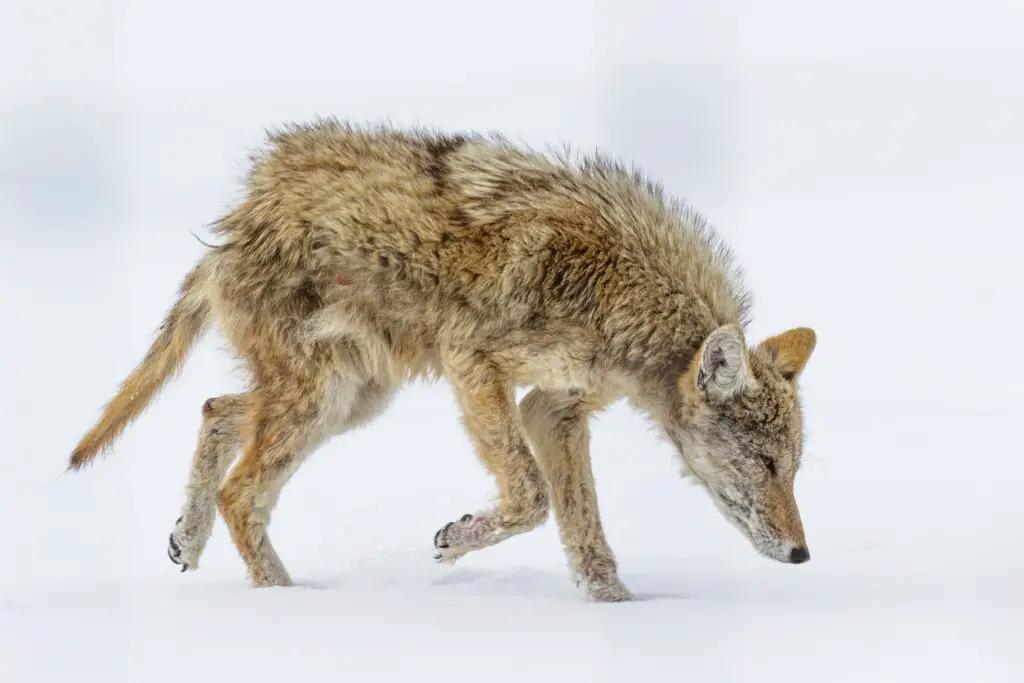Coyotes with mange suffer a miserable fate. Sarcoptic mange, the result of an infestation caused by Sarcoptes scabies canis, causes severe itching, hair loss, and numerous secondary infections.
While some coyotes with mange will be obvious (covered in crusty, bleeding scales and nearly furless), newly infested coyotes will show no symptoms. Symptomless coyotes with mange are a problem for coyote hunters and pet owners.
If you are handling coyotes or live in an area where coyotes with mange might reside, you need to know how to identify mange and avoid bringing it home to yourself and your pets.
Related: The day-to day life of a coyote.
Related: Is this coyote poop in my yard?

Coyotes with mange.
Mange is highly contagious and spreads quickly to other coyotes, animals, pets, and humans. The Sarcoptes scabiei canis mite is a parasite that burrows into skin to live and deposit eggs, often creating an allergic reaction (scabies).
Coyotes with mange can live for several years; however, most soon succumb to the colder winter temperatures due to hair loss. In addition, mange causes coyotes to excessively scratch themselves raw, often opening wounds in their skin and making them susceptible to infection.
Coyotes with mange display unusual behavior, such as spending most of their time and energy scratching their itchy skin rather than pursuing prey food or seeking shelter. The lack of desire to secure food leads to decreasing energy levels, dehydration, and death.
In one eleven-year study, the percentage of coyotes with mange in a given population was 16%. That’s a large enough percentage to create an unhealthy number of coyotes exhibiting unusual behavior.
Related: How to tell a coyote from a fox.
Related: Is that a wolf or a coyote?

Suburban coyotes with mange.
Coyotes with mange that live in the suburbs may act and look so strange as to be misidentified as having rabies or distemper. However, that isn’t the real hazard they can create.
Aside from all the other problems associated with suburban coyotes, coyotes with mange bring increased likelihood of contact with humans and pets.
Mangy coyotes tend to be more active during the day. They are also desperate and hungry enough to forgo their instinctive fear of humans to enter residential areas in search of easy meals.
These searches mean probable contact with pets, pet bowls, and pet yards and the lawns pets play and sleep on.
Even if direct contact does not occur, mange mites can survive and persist in these areas for a long time. Indeed, if coyotes with mange build dens under your shed, the mites will wait for your dog or cat to visit that shelter.
Unfortunately, if your pet is exposed to mange, it might take a month for you to begin seeing the symptoms. By then, the infestation may have spread throughout your entire home.
Related: How to translate coyote howls.

Can you help a coyote with mange?
You will find many websites with suggestions about how to help coyotes with mange. You might even feel your heartstrings pulled by the sight of a nearly hairless coyote lying on a sunny sidewalk.
Your best course of action is to report it and move along. Suburban coyotes with mange can also have rabies and distemper. Feeding or approaching a coyote is just asking for more problems. Trust me, you’ll never catch it—and if you did, you would be bitten for your efforts.
Related: Coyotes make for terrible pets.
Do coyotes with mange ever recover?
Whether or not coyotes with mange will ever recover depends on various circumstances. Coyotes with intact immune systems may survive and eventually improve. But weak coyotes, like the old and injured, are quickly overtaken by the disease and usually die.
Indeed, most coyotes that are well-fed, healthy, and unstressed can fight off the effects of scabies without any severe problems.
The primary factor, however, concerning the survival rate of coyotes with mange is the weather and the season. Coyotes with mange in the spring and summer might survive. Unfortunately, those with mange in the winter and fall often succumb to the colder temperatures.
Related: Can you hunt coyotes in your state?

Handling coyotes with mange in the wild: Coyote hunting.
Mange may kill more coyotes than coyote hunters and cars. Indeed, coyote hunters should recognize that the coyote they just took could be infected with mange. So how do these hunters protect themselves, their homes, and their pets from accidentally bringing mange back in the truck?
While some coyotes with mange may be discernible from a distance, many are not. Your first step to avoiding mange is never to carry a dead coyote. Instead, use a coyote drag to remove a coyote from the field. Never toss a coyote over your shoulder; you could provide a warm spot for the mange to settle into.
Keep dead coyotes away from your pets and outside your home—skin and flesh coyotes outside or in a designated place, free from other animals and livestock. Always wear gloves when handling coyote carcasses.
Treat any pets or bedding areas that come into contact with coyote carcasses with a mange dip.

Coyotes with mange that are discovered after hunting should not touched. Either bury or burn a coyote with visible mange in the field.
Never let hunting dogs approach or come into contact with dead coyotes. If they do, treat with the mange dip as a precaution.
In the end, coyotes with mange are to be pitied. Avoided and shunned, perhaps even shot, but pitied, none-the-less.

